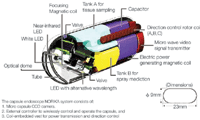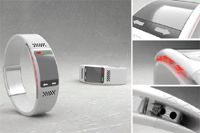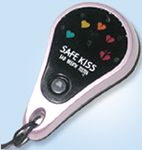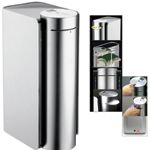New Technologies
New Technologies
Stomach robot
Wouldn't it be fascinating to see what's happening in your stomach and digestive tract? Well now you can in the comfort of your own home because Norkia have released the capsule endoscope. It consists of
- A microcapsule CCD camera
- An external controller to wirelessly control and operate the capsule
- A coil-embedded vest for power transmission and direction control.
The dimension of the capsule camera is 9 mm in diameter and 23 mm in length. The case is made of resin. Inside the capsule, three rotor coils for posture control are located surrounding the capsule. Magnetic coils for focus adjustment and four LEDs are placed around the camera lens. Two tanks with sampling valves feature in the centre that can be used for medication or sampling. A capacitor to store electric power and a microwave video signal transmitter make the capsule complete.

All you have to do is swallow it and use the remote controller to move it around your stomach!
For more information, visit http://tinyurl.com/2mcap9
Wrist alarm
Now there is no need to miss a timing alarm in the lab because it wasn't loud enough. The personal alarm watch is a wrist device that operates by having multidirectional microphones integrated into the strap that can detect a drastic change in ambient sound level or pick up specially assigned frequencies and alert the user by vibrating the wrist.
For more information, visit www.yankodesign.com

Check your breath
A small device for checking your personal hygiene levels has appeared on the market. The Kiss Me Meter is a personal bad breath detector designed to eliminate embarrassing situations. It uses MEMS gas sensors to detect specific gases from your teeth or stomach and shows five levels of mouth smell in different colours of LED display. Furthermore, the detector is equipped with a recalibration function and, according to the manufacturers, is accurate and small enough to carry alongside your mobile phone.
For more information, visit http://kissmemeter.com/

CD Storage
Do you find it difficult to locate particular CDs or DVDs in the lab? You may have a storage rack but in which rack is your data back-up or the CD with your latest results? The solution can be found in this modern metal unit that stores up to 100 CDs or DVDs. It has a high resolution 1.8 in. colour TFT panel display with a number pad allowing you to organize and enter each title for the CD or DVD collection.

BlueDot's Divita BDM-100S makes it easy to find and store the CDs.
For more information, visit www.audiocubes.com

Determining Enhanced Sensitivity to Odors due to Anxiety-Associated Chemosignals with GC
May 8th 2025Based on their hypothesis that smelling anxiety chemosignals can, like visual anxiety induction, lead to an increase in odor sensitivity, a joint study between the University of Erlangen-Nuremberg (Erlangen, Germany) and the Fraunhofer Institute for Process Engineering and Packaging (Freising, Germany) combined behavioral experiments, odor profile analysis by a trained panel, and instrumental analysis of odorants (gas chromatography-olfactometry) and volatiles (gas chromatography-mass spectrometry).
Investigating 3D-Printable Stationary Phases in Liquid Chromatography
May 7th 20253D printing technology has potential in chromatography, but a major challenge is developing materials with both high porosity and robust mechanical properties. Recently, scientists compared the separation performances of eight different 3D printable stationary phases.
Detecting Hyper-Fast Chromatographic Peaks Using Ion Mobility Spectrometry
May 6th 2025Ion mobility spectrometers can detect trace compounds quickly, though they can face various issues with detecting certain peaks. University of Hannover scientists created a new system for resolving hyper-fast gas chromatography (GC) peaks.

.png&w=3840&q=75)

.png&w=3840&q=75)



.png&w=3840&q=75)



.png&w=3840&q=75)










